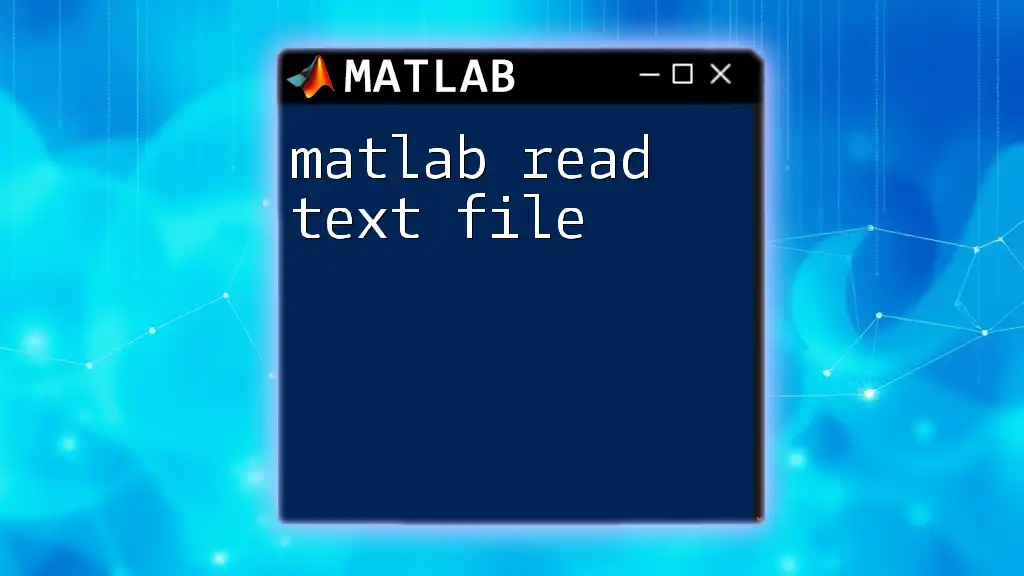The `readfile` function in MATLAB allows users to efficiently read data from a file into a matrix or an array, making it easier to analyze and manipulate datasets.
Here’s a simple code snippet demonstrating how to use `readtable` to read a CSV file:
data = readtable('yourfile.csv');
Understanding the `readfile` Command
Definition and Purpose
The `matlab readfile` command is an essential function used to read various types of data files into MATLAB. It simplifies the process of importing data, allowing users to analyze and manipulate the imported data efficiently. Understanding how to properly utilize this command can greatly enhance your productivity while working in MATLAB.
Types of Data Files in MATLAB
Text Files
Text files, such as `.txt` or `.csv`, store data in a human-readable format. They typically consist of plain text and can be comma-separated or tab-separated. This makes them suitable for exporting data from other applications or for sharing datasets.
Binary Files
Binary files, such as `.mat` files, store data in a format specific to MATLAB. They are not human-readable but are more efficient for storing large datasets. MATLAB allows direct access to the variables stored within these files, making them convenient for data interchange within MATLAB itself.
Image Files
MATLAB can also handle various image file formats, allowing users to read and manipulate images for analysis or processing tasks. While this falls outside the scope of the `readfile` command, it’s worth noting that file reading in MATLAB is versatile.

Using `readfile` in MATLAB
Basic Syntax
The syntax for using the `matlab readfile` command is straightforward. You can import data from the specified file like so:
data = readfile('data.txt');
Here, `data` becomes an array that holds the contents of the specified file. The command seamlessly loads the data for further analysis.
Parameters of `readfile`
File Name
The primary parameter is the name of the file you wish to read. Ensure the file is located within your current working directory for MATLAB to access it without issues.
Options
You can customize how the data is read using various options such as delimiters, data formats, and more. These options enhance flexibility and make it easier to work with diverse data types.

Practical Applications of `readfile`
Reading a Text File
To read a simple text file, follow these steps:
-
Create a text file named `sample.txt` containing the following text:
Apple Banana Cherry -
Use the `readfile` command to read its contents:
data = readfile('sample.txt');
disp(data);
When executed, this code will display:
Apple
Banana
Cherry
Reading a CSV File
CSV files are commonly used for data exchange. To read a CSV file, use the same approach:
data = readfile('data.csv');
This command will import the data into the `data` array, allowing you to manipulate it as needed.
Reading Data from a MATLAB MAT File
When working with MATLAB-specific files, such as .mat files, the `readfile` command is replaced by the `load` command. This is specifically tailored for loading MATLAB data files:
data = load('data.mat');
This allows direct access to the variables stored within the MAT file.
Error Handling
When working with file imports, errors can occur. Therefore, it’s essential to implement error handling mechanisms. For example:
try
data = readfile('non_existent.txt');
catch ME
disp(['Error: ', ME.message]);
end
This code attempts to read a nonexistent file and captures the error, displaying a message to the user instead of crashing the program.

Advanced Techniques with `readfile`
Custom Options
You can enhance the functionality of `readfile` by specifying custom options. For instance, if you're dealing with a CSV file with a different delimiter or encoding, you can set these options directly:
opts = delimitedTextImportOptions("NumVariables", 3);
opts.Delimiter = ",";
data = readfile('data.csv', opts);
Reading in Portions of Data
In scenarios where you only need a specific portion of a dataset, `readfile` allows you to read designated rows or columns:
data = readfile('data.csv', 'Range', '1:10'); % Read only the first 10 rows
This feature is particularly useful for large datasets where performance optimization is essential.

Best Practices for Using `readfile`
Optimizing Performance
When handling large files, it’s important to be mindful of performance. Read data in chunks or utilize built-in MATLAB functions designed to handle larger files efficiently.
Data Verification and Validation
After you have imported data, it’s crucial to verify and validate its integrity. Always check for unexpected values or formatting issues that may have occurred during the import process.
Documentation and Comments
Maintain clarity in your code by documenting functions and commands. Commenting your code helps not only yourself but also others who may work with your code in the future.

Conclusion
The `matlab readfile` command serves as a powerful tool for importing data into MATLAB, enhancing your ability to conduct comprehensive analyses and simulations. By mastering its usage, along with its options and error-handling techniques, you can streamline your data processing workflow and leverage the full capabilities of MATLAB. Continuing to explore and learn about the intricacies of file handling in MATLAB will further enrich your programming skills and project outcomes.

















